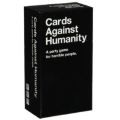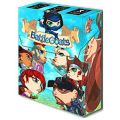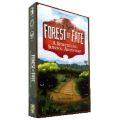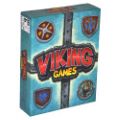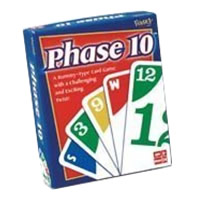
Official Phase 10 Rules
How To Play Phase 10
2 - 6
Players
8+
Ages
90 MIN
Play Time
$6
Price
Phase 10 is a new variation of the popular card games Rummy, where players need to pass through ten phases to win. Each phase presents a player with a more challenging and complicated task, thus demanding strategic thinking and adaptation. In Phase 10, the key to success is to complete your current phase each round so that you may advance to the next level in the game. Failure to do so, however, means that the player is stuck in that phase until he or she can complete it, adding an extra degree of tension and excitement to the game.
To start a game, each player draws a hand of 10 cards, with the remaining deck forming a draw pile in the center of the table. The game involves completing the ten phases, each requiring certain combinations of sets or runs. It is a game that can be played by 2 to 6 players, and that's what makes it flexible and fun for all ages. Whether you are planning the move you can make or anxious about the end result of every round, Phase 10 promises hours of challenge and fun for everyone. Gather your friends and family around, shuffle the deck, and enjoy the thrill of Phase 10 today!
To start a game, each player draws a hand of 10 cards, with the remaining deck forming a draw pile in the center of the table. The game involves completing the ten phases, each requiring certain combinations of sets or runs. It is a game that can be played by 2 to 6 players, and that's what makes it flexible and fun for all ages. Whether you are planning the move you can make or anxious about the end result of every round, Phase 10 promises hours of challenge and fun for everyone. Gather your friends and family around, shuffle the deck, and enjoy the thrill of Phase 10 today!
- Reference Cards
- One Deck Of 108 Cards
- Official Phase 10 Game Rules And Instructions

The objective is to be the first player to successfully complete all 10 Phases. In the event of a tie, the player with the lowest score emerges as the winner.

Perparation: Select a player to act as the dealer. The dealer thoroughly shuffles the deck and distributes 10 cards, face down, one by one, to each player. Players hold their 10 cards privately, ensuring they remain hidden from other players. Position the remaining deck face down in the center of the play area to serve as the draw pile. Flip the top card of the draw pile over and position it beside the draw pile, forming the discard pile.
Game Play: The player positioned to the left of the dealer initiates the game. Subsequent turns progress in a clockwise manner. On your turn, you may draw one card, either from the top of the draw pile or from the top of the discard pile, and incorporate it into your hand. To conclude your turn, you must discard one card from your hand onto the top of the discard pile.
In the initial round, each player strives to complete Phase 1. A Phase comprises a specific combination of cards, which can include sets, runs, cards of a single color, or a blend of sets and runs. There are ten distinct Phases to achieve.
Sets: A set consists of two or more cards with identical numbers. For instance, Phase 1 entails two sets of three cards each, such as three "7s" and three "10s." Alternatively, the sets can comprise the same number, like three "10s" and three additional "10s." These sets may feature cards of any color combination.
Runs: A run encompasses four or more cards arranged in sequential order. As an example, Phase 2 necessitates a run of four cards, such as "3," "4," "5," "6." These cards can display any combination of colors.
All One Color: All cards in this category share the same color. For instance, Phase 8 demands seven cards of a single color, such as seven red cards or seven green cards. The cards need not be in numerical order.
Wild Cards: A "Wild" card can substitute for a numbered card or any color to fulfill a Phase requirement. For example, if a player aims to create a run of four cards but only possesses "3," "4," and "6," they can use a "Wild" card as a "5" to complete the run. Similarly, if a player has six green cards and lacks a seventh, they can utilize a "Wild" card as a green card to satisfy Phase 8.
Players have the flexibility to utilize multiple "Wild" cards when completing a Phase. There's no limit to the number of "Wild" cards they can employ as long as they include at least one natural card.
Once a "Wild" card has been incorporated into a Phase, it cannot be substituted for another card to fulfill a different requirement but must retain its assigned value until the end of the hand.
In the event that the dealer initiates the discard pile with a "Wild" card, the card remains available for the first player to pick up.
Skip Cards: Skip cards serve a single function: to skip another player's turn. To activate, discard the "Skip" card during your turn and designate the player who will miss their next turn. Upon drawing a "Skip" card, you have the option to discard it immediately or reserve it for future use. It's important to note that a "Skip" card cannot be utilized to complete Phase 8 or any other Phase.
A "Skip" card cannot be retrieved from the discard pile at any point. Only one "Skip" card can be played against each player per round. When a player is skipped, a round refers to one complete rotation around the table. If the dealer initiates the discard pile with a "Skip" card, the first player's initial turn is automatically skipped.
Making A Phase: If you possess the necessary cards to complete a Phase during your turn, lay the Phase face-up on the table before discarding. For instance, if you're aiming for Phase 1 and you have 3 "5s" and 2 "7s," and you draw another "7," you can form 2 sets of 3 and place them down. In the subsequent hand, you'll progress to Phase 2.
It's imperative to have all the cards required for a Phase in your hand before laying it down. While you can lay down more cards than the minimum requirement for a Phase, they must directly contribute to the Phase already laid down.
For instance, if you lay down 3 "5s" and 3 "7s" to complete Phase 1, and you have two more "5s" in hand, you can immediately add them to the existing set in the same turn. However, if another player makes Phase 1 by laying down 3 "6s" and 3 "8s," they cannot add their remaining 3 "10s" because Phase 1 requires exactly 2 sets.
Only one Phase can be completed per hand. If successful, you proceed to the next Phase in the subsequent hand. Failure to complete a Phase means you must attempt it again in the next hand. Therefore, players may not all be pursuing the same Phase simultaneously.
Phases must be completed in sequential order, from 1 to 10. For instance, if you aim for Phase 4 and lay down a run of 9 cards, it counts as 1 run of 7 for Phase 4 but cannot be applied to Phase 5 or Phase 6.
You receive credit for completing a Phase as soon as you lay it down, irrespective of winning the hand. Multiple players can often complete a Phase in the same hand.
Hitting: Hitting is a method to dispose of leftover cards after completing a Phase. You achieve a hit by placing a card directly onto an existing Phase, ensuring it fits seamlessly with the cards already laid down. For example, you can add one or more "4s" to a player's set of "4s," or insert a "2" into a run of "3," "4," "5," "6," along with a "7" and an "8" if available. This also applies to adding green cards to a set of seven green cards in Phase 8, or incorporating a "Wild" card of any color. However, before executing a hit, you must have already laid down your own Phase, and hits can only be made during your turn. You have the liberty to hit your own cards, another player's cards, or both.
Going Out / Finishing A Hand: After completing a Phase, players endeavor to "go out" as swiftly as possible. To achieve this, you must eliminate all your cards either by discarding or hitting onto an existing Phase. The player who goes out first wins the hand. The winner of the hand, along with any other players who have also completed their Phase, advance to the next Phase for the subsequent hand. Players tally the cards left in their hands (fewer cards left is better), and all cards are then shuffled for a new hand. Remember, if you did not complete your Phase before another player went out, you must continue working on the same Phase in the next hand.
Scoring: Each player maintains a running total using paper and pencil. The winner of the hand scores zero, while the remaining players accrue points based on the cards still in their hands:
The Winner: The first player to complete Phase 10 at the end of a hand emerges as the winner. In case two or more players complete Phase 10 in the same hand, the player with the fewest total points is declared the winner. If a tie persists, the tied players replay Phase number 10, and the first one to go out becomes the winner.
Variations: In this variation, players engage in 10 hands, progressing to the next Phase regardless of whether they complete the current Phase. For instance, in the first hand, players aim for Phase 10, followed by Phase 2 in the second hand, and so forth. At the conclusion of the ten hands, the player with the lowest total score emerges as the winner.
In this alternative, players determine the number of Phases required to win, such as 5 or 7 Phases. This decision must be made before the game commences, while all other rules remain unchanged. This variation offers a shorter gameplay experience.
In this variation, players opt to play only the even-numbered Phases (2, 4, 6, 8, 10) instead of all Phases. All other rules remain intact, providing a different gameplay dynamic.
Please keep in mind that the official Phase 10 PDF rules listed below could be different depending on the version you have. They should be an exact copy of what came in your original packaging. Download them to view now or print them for later use.
Game Play: The player positioned to the left of the dealer initiates the game. Subsequent turns progress in a clockwise manner. On your turn, you may draw one card, either from the top of the draw pile or from the top of the discard pile, and incorporate it into your hand. To conclude your turn, you must discard one card from your hand onto the top of the discard pile.
In the initial round, each player strives to complete Phase 1. A Phase comprises a specific combination of cards, which can include sets, runs, cards of a single color, or a blend of sets and runs. There are ten distinct Phases to achieve.
- 2 sets of 3
- 1 set of 3 + 1 run of 4
- 1 set of 4 + 1 run of 4
- 1 run of 7
- 1 run of 8
- 1 run of 9
- 2 sets of 4
- 7 cards of 1 color
- 1 set of 5 + 1 set of 2
- 1 set of 5 + 1 set of 3
Sets: A set consists of two or more cards with identical numbers. For instance, Phase 1 entails two sets of three cards each, such as three "7s" and three "10s." Alternatively, the sets can comprise the same number, like three "10s" and three additional "10s." These sets may feature cards of any color combination.
Runs: A run encompasses four or more cards arranged in sequential order. As an example, Phase 2 necessitates a run of four cards, such as "3," "4," "5," "6." These cards can display any combination of colors.
All One Color: All cards in this category share the same color. For instance, Phase 8 demands seven cards of a single color, such as seven red cards or seven green cards. The cards need not be in numerical order.
Wild Cards: A "Wild" card can substitute for a numbered card or any color to fulfill a Phase requirement. For example, if a player aims to create a run of four cards but only possesses "3," "4," and "6," they can use a "Wild" card as a "5" to complete the run. Similarly, if a player has six green cards and lacks a seventh, they can utilize a "Wild" card as a green card to satisfy Phase 8.
Players have the flexibility to utilize multiple "Wild" cards when completing a Phase. There's no limit to the number of "Wild" cards they can employ as long as they include at least one natural card.
Once a "Wild" card has been incorporated into a Phase, it cannot be substituted for another card to fulfill a different requirement but must retain its assigned value until the end of the hand.
In the event that the dealer initiates the discard pile with a "Wild" card, the card remains available for the first player to pick up.
Skip Cards: Skip cards serve a single function: to skip another player's turn. To activate, discard the "Skip" card during your turn and designate the player who will miss their next turn. Upon drawing a "Skip" card, you have the option to discard it immediately or reserve it for future use. It's important to note that a "Skip" card cannot be utilized to complete Phase 8 or any other Phase.
A "Skip" card cannot be retrieved from the discard pile at any point. Only one "Skip" card can be played against each player per round. When a player is skipped, a round refers to one complete rotation around the table. If the dealer initiates the discard pile with a "Skip" card, the first player's initial turn is automatically skipped.
Making A Phase: If you possess the necessary cards to complete a Phase during your turn, lay the Phase face-up on the table before discarding. For instance, if you're aiming for Phase 1 and you have 3 "5s" and 2 "7s," and you draw another "7," you can form 2 sets of 3 and place them down. In the subsequent hand, you'll progress to Phase 2.
It's imperative to have all the cards required for a Phase in your hand before laying it down. While you can lay down more cards than the minimum requirement for a Phase, they must directly contribute to the Phase already laid down.
For instance, if you lay down 3 "5s" and 3 "7s" to complete Phase 1, and you have two more "5s" in hand, you can immediately add them to the existing set in the same turn. However, if another player makes Phase 1 by laying down 3 "6s" and 3 "8s," they cannot add their remaining 3 "10s" because Phase 1 requires exactly 2 sets.
Only one Phase can be completed per hand. If successful, you proceed to the next Phase in the subsequent hand. Failure to complete a Phase means you must attempt it again in the next hand. Therefore, players may not all be pursuing the same Phase simultaneously.
Phases must be completed in sequential order, from 1 to 10. For instance, if you aim for Phase 4 and lay down a run of 9 cards, it counts as 1 run of 7 for Phase 4 but cannot be applied to Phase 5 or Phase 6.
You receive credit for completing a Phase as soon as you lay it down, irrespective of winning the hand. Multiple players can often complete a Phase in the same hand.
Hitting: Hitting is a method to dispose of leftover cards after completing a Phase. You achieve a hit by placing a card directly onto an existing Phase, ensuring it fits seamlessly with the cards already laid down. For example, you can add one or more "4s" to a player's set of "4s," or insert a "2" into a run of "3," "4," "5," "6," along with a "7" and an "8" if available. This also applies to adding green cards to a set of seven green cards in Phase 8, or incorporating a "Wild" card of any color. However, before executing a hit, you must have already laid down your own Phase, and hits can only be made during your turn. You have the liberty to hit your own cards, another player's cards, or both.
Going Out / Finishing A Hand: After completing a Phase, players endeavor to "go out" as swiftly as possible. To achieve this, you must eliminate all your cards either by discarding or hitting onto an existing Phase. The player who goes out first wins the hand. The winner of the hand, along with any other players who have also completed their Phase, advance to the next Phase for the subsequent hand. Players tally the cards left in their hands (fewer cards left is better), and all cards are then shuffled for a new hand. Remember, if you did not complete your Phase before another player went out, you must continue working on the same Phase in the next hand.
Scoring: Each player maintains a running total using paper and pencil. The winner of the hand scores zero, while the remaining players accrue points based on the cards still in their hands:
- 5 points for each card numbered 1-9
- 10 points for each card numbered 10-12
- 15 points for each "Skip" card
- 25 points for each "Wild" card
The Winner: The first player to complete Phase 10 at the end of a hand emerges as the winner. In case two or more players complete Phase 10 in the same hand, the player with the fewest total points is declared the winner. If a tie persists, the tied players replay Phase number 10, and the first one to go out becomes the winner.
Variations: In this variation, players engage in 10 hands, progressing to the next Phase regardless of whether they complete the current Phase. For instance, in the first hand, players aim for Phase 10, followed by Phase 2 in the second hand, and so forth. At the conclusion of the ten hands, the player with the lowest total score emerges as the winner.
In this alternative, players determine the number of Phases required to win, such as 5 or 7 Phases. This decision must be made before the game commences, while all other rules remain unchanged. This variation offers a shorter gameplay experience.
In this variation, players opt to play only the even-numbered Phases (2, 4, 6, 8, 10) instead of all Phases. All other rules remain intact, providing a different gameplay dynamic.
Please keep in mind that the official Phase 10 PDF rules listed below could be different depending on the version you have. They should be an exact copy of what came in your original packaging. Download them to view now or print them for later use.
Share with us your comments, funny stories, tips, advice, strategies, creative ways to play, questions about playing, problems with the directions, etc. All submissions will be reviewed within 24 hours.
Allen Smith says:
When you lay down your tenth phase is the game over or is it still required that you “go out”
11-10-2021
When you lay down your tenth phase is the game over or is it still required that you “go out”
Lily says:
I’m here to help answer questions if you need help I just know the rules because I have played the game multiple times a run has to go in order like 1 2 3 4 or 9 10 11 12 you use the numbers just like in math. The round means the same as a hand and there isn’t a limit on how many times someone can be skipped. Someone can pick up the wild card from the discard pile. You have to have 10 cards when it’s not your turn 11 when you have picked up a card. You have to discard to go out. You have to discard every turn. You shuffle the cards for the second hand. You can lay down the same card you picked up. I’m sorry but I don’t know what the rules are for hitting, if a card is upside down, and does everyone get a turn after someone goes out.
09-21-2021
I’m here to help answer questions if you need help I just know the rules because I have played the game multiple times a run has to go in order like 1 2 3 4 or 9 10 11 12 you use the numbers just like in math. The round means the same as a hand and there isn’t a limit on how many times someone can be skipped. Someone can pick up the wild card from the discard pile. You have to have 10 cards when it’s not your turn 11 when you have picked up a card. You have to discard to go out. You have to discard every turn. You shuffle the cards for the second hand. You can lay down the same card you picked up. I’m sorry but I don’t know what the rules are for hitting, if a card is upside down, and does everyone get a turn after someone goes out.
Travis says:
Question, If a player hits a run of another player by adding a 6 to the run does the player with the run get to add a 7 to the run after being hit to discard or go out? Also, can other players keep adding to the run that was hit to further the run to discard or go out.
07-11-2021
Question, If a player hits a run of another player by adding a 6 to the run does the player with the run get to add a 7 to the run after being hit to discard or go out? Also, can other players keep adding to the run that was hit to further the run to discard or go out.
Cj says:
So let's say Im about to lay down my phase and I'm trying to get rid of the remainder of my cards to go out. ...can I pick up from the discard pile and lay down the same card I picked up from the discard pile?
01-08-2020
So let's say Im about to lay down my phase and I'm trying to get rid of the remainder of my cards to go out. ...can I pick up from the discard pile and lay down the same card I picked up from the discard pile?
Marty says:
no one is answering my question....after someone lays down their phase does everyone get a final chance to lay down or are they stuck with what they have?
01-16-2019
no one is answering my question....after someone lays down their phase does everyone get a final chance to lay down or are they stuck with what they have?
Nada says:
Are phases of the fisrt hand shuffled for the second?
06-28-2018
Are phases of the fisrt hand shuffled for the second?
Grace says:
Do you have to discard every turn and can you make sets and runs on the side?
06-18-2018
Do you have to discard every turn and can you make sets and runs on the side?
Bri says:
Honestly this game is very simple. You keep ten cards in hand at all times until you lay down your phase. One person can be skipped each round, meaning they can be skipped one time until each player has gone aside from them. Skips can't be used in a phase - sets, runs, or 7 of 1 color. Once you lay down your phase, you must still draw from the discard pile and discard one card, unless it plays on someone else's phase that they have layed down. Honestly the rules aren't that complicated if you actually read them instead of skimming them.
01-19-2018
Honestly this game is very simple. You keep ten cards in hand at all times until you lay down your phase. One person can be skipped each round, meaning they can be skipped one time until each player has gone aside from them. Skips can't be used in a phase - sets, runs, or 7 of 1 color. Once you lay down your phase, you must still draw from the discard pile and discard one card, unless it plays on someone else's phase that they have layed down. Honestly the rules aren't that complicated if you actually read them instead of skimming them.
Vince says:
Must a person discard when they go out to win?
12-26-2017
Must a person discard when they go out to win?
Cookie says:
Can you hit a wild card with an original card when hitting?
11-25-2017
Can you hit a wild card with an original card when hitting?
Jeremy says:
These instructions are terrible... I have many of the questions above, and no one is answering them. Mattel, you suck.
11-19-2017
These instructions are terrible... I have many of the questions above, and no one is answering them. Mattel, you suck.
David Evans says:
If a card is upside down in draw pile accidently from shuffle, can it be picked up and played or do you burn it.
07-02-2017
If a card is upside down in draw pile accidently from shuffle, can it be picked up and played or do you burn it.
Marlene says:
Hi. I purchased a Phase 10 20th anniversary game maybe 5 to ten years ago. We opened it and started reading the instructions which have been somewhat confusing as to how the ten dice and cards are mixed together. We went on site to see if that game set might have developed clearer definitions of the dice card mix. However, you do not list 20th but a 25th anniversary set. Can you help our team of card players? Marlene
04-02-2017
Hi. I purchased a Phase 10 20th anniversary game maybe 5 to ten years ago. We opened it and started reading the instructions which have been somewhat confusing as to how the ten dice and cards are mixed together. We went on site to see if that game set might have developed clearer definitions of the dice card mix. However, you do not list 20th but a 25th anniversary set. Can you help our team of card players? Marlene
Ray says:
I have a quick question, Ok so on a set of 3 , are you allowed to use two skip and a wild card ?
03-17-2017
I have a quick question, Ok so on a set of 3 , are you allowed to use two skip and a wild card ?
Susie says:
Do you keep 10 cards in your hand at all time, if not how do you complete the phases
02-23-2017
Do you keep 10 cards in your hand at all time, if not how do you complete the phases
Johny says:
Fun game if you want something to play but still be able to talk to your friends. We played this for a couples night. Rules are pretty self explanatory and learning how to play is very easy.
08-13-2015
Fun game if you want something to play but still be able to talk to your friends. We played this for a couples night. Rules are pretty self explanatory and learning how to play is very easy.
Hope says:
Say a person discards a wild card into the discard pile, can the next person pick it up?
07-27-2015
Say a person discards a wild card into the discard pile, can the next person pick it up?
scott says:
How do you play out of the draw pile and what do you do when the skip card is laying on top of the cards you want to pick up
01-15-2014
How do you play out of the draw pile and what do you do when the skip card is laying on top of the cards you want to pick up
Maryann says:
after a player achieves his phase can he add other items? Example: 2 sets of 3 - then could he add another set of 3 in the same hand?
01-09-2014
after a player achieves his phase can he add other items? Example: 2 sets of 3 - then could he add another set of 3 in the same hand?
Jenny says:
We play this game a lot and have come up with different phases that aren't in the game rules. Some or more difficult and some are easier depending on who we are playing with. We also alter the rules a little more when we're playing with kids involved.
10-14-2013
We play this game a lot and have come up with different phases that aren't in the game rules. Some or more difficult and some are easier depending on who we are playing with. We also alter the rules a little more when we're playing with kids involved.
jason says:
we were going to play and some people have played it so that after you layed down your set you did not pick a card on your turn until you go out. Is this rule right?
04-23-2011
we were going to play and some people have played it so that after you layed down your set you did not pick a card on your turn until you go out. Is this rule right?
Dee says:
I'm somewhat puzzled I have been playing Phase 10 for about 6 years snd just the other day it was brought to my attention on the "skip" rules all this time I had the impression that any one person could be skipped only once during a"hand", but it was brought up that the rule reads during a "round" . Isnt that going to make the game longer and is that the "rule" during a "round" ALready it takes 6 hours or longer to complete the game.
12-27-2010
I'm somewhat puzzled I have been playing Phase 10 for about 6 years snd just the other day it was brought to my attention on the "skip" rules all this time I had the impression that any one person could be skipped only once during a"hand", but it was brought up that the rule reads during a "round" . Isnt that going to make the game longer and is that the "rule" during a "round" ALready it takes 6 hours or longer to complete the game.
Dee says:
Why is it the game usually come with four(4) phase set cards, and the last games I purchased came with only two (2)?
12-27-2010
Why is it the game usually come with four(4) phase set cards, and the last games I purchased came with only two (2)?
helen says:
if you have to make a run of four can you use 11, 12, 1, 2
12-25-2010
if you have to make a run of four can you use 11, 12, 1, 2
sue says:
we were going to play and some people have played it so that after you layed down your set you did not pick a card on your turn until you go out. Is this rule right?
08-08-2010
we were going to play and some people have played it so that after you layed down your set you did not pick a card on your turn until you go out. Is this rule right?
molly says:
it is the best game ever if u have more then 2 people because u can skip some one eles instead of only 1 other person
06-15-2010
it is the best game ever if u have more then 2 people because u can skip some one eles instead of only 1 other person
Annette says:
I love this game I learned to play it at my friends house. Bought some for my family and friends (tin can version) but it came without a score pad and I don't remember how to keep score from playing it once at my friends house, so a little disappointed at that.
03-14-2009
I love this game I learned to play it at my friends house. Bought some for my family and friends (tin can version) but it came without a score pad and I don't remember how to keep score from playing it once at my friends house, so a little disappointed at that.
Here are some other games you might like to play at your next get together. Learning how to play new games can feel daunting at first but once you get the hang of it, it can be really fun to try out new games. You can also use our search feature at the top of the page to search for a specific criteria that might interest you. Who knows - you might just find your next favorite game.
